This post may contain affiliate links. If you use these links to buy something we may earn a commission. Thanks.
Shade-loving evergreen ground covers can be difficult to find, as most do best with no shade. Lucky for you, I’ve compiled a list of several shade-tolerant ground covers that either have evergreen or semi-evergreen foliage.
These evergreens are perfect for positioning beneath large shade trees or anything else that casts various amounts of shade.

Most true year-round evergreens need at least a partial shade position to remain green and lush.
To quickly find what you’re looking for, I’ve divided this post into 4 subheadings.
- Full shade evergreens
- Partial shade evergreens
- Full shade semi-evergreens
- Partial shade semi-evergreens
6 Evergreen Ground Covers Suitable for Full Shade
These evergreens will keep their foliage 12 months of the year in the warmer side of their hardiness zone range and can grow in full shade. Many of these options also thrive in partial and no-shade positions.
Box Huckleberry (Gaylussacia brachycera)

Fruit-producing ‘box’ huckleberries grow well in full shade and semi-shade! The best part is once they’re established, their edible (but tasteless) fruit is still produced even with minimal sun.
Their foliage is a dark green from summer through winter while spring offers a bronze colouring. Box huckleberry is evergreen in zones 5-9.
- Height: 6-18 inches.
- Range: Native to Eastern North America
- Climate: Zones 5-9
- Functions: A popular edible ground cover in food forests. Dense carpeting ground cover for any amount of light.
- Light requirements: Full, semi, or no shade
- Soil preferences: Moist, drained, rich, and neutral-acidic soils.
Few small nurseries sell this specific variety.
Bigleaf periwinkle (Vinca major)

This evergreen vining ground cover grows in all sun levels and is very resilient to dry spells. This vine is often used in “annual” hanging baskets as it beautifully cascades long lengths and withstands quick-drying soils in sun or shade.
In the mild winters of zones 7-9 this perennial is evergreen—keeping its foliage year-round. They flower very well in all but deep shade but are primarily used for erosion control in forest gardens.
- Height: 12-18 inches
- Range: Europe and Africa
- Climate: Zones 7-9
- Functions: Ornamental April to June flowers and vibrant or variegated foliage. Erosion control. Quick ground coverage.
- Light requirements: Full/deep, partial, or no shade.
- Soil preferences: Dry or moist soil and is drought resistant. Suitable for light or heavy soils, including heavy clay.
Seeds and various flower colors are available here and solid green or variegated foliage are available in containers here.
Twinflower (Linnaea borealis)

Twin flowers bloom from May to August on a creeping evergreen vine with a dense carpeting habit. This ground cover is a perfect choice for acidic soils as it requires a below-7 pH to thrive.
- Height: 4 inches
- Range: Northern hemisphere
- Climate: Zones 2-6
- Functions: The leaves are edible and potentially medicinal for women. A scented ground cover for acidic environments, rock gardens, wild, native, or woodland gardens, and food forests.
- Light requirements: Full/deep shade to partial shade.
- Soil preferences: Moist soil with light to heavy texture.
Wood Brook Native Plant Nursery offers twinflower here.
Creeping Bramble (Rubus tricolor)

An evergreen ground cover that produces fruit, even in shade! Creeping bramble thrives best in full or partial shade as it receives protection from intense heat waves.
The foliage stays on all year in warmer climates above zone 7. In zone 6, however, this will likely perform as a semi-evergreen, meaning it will lose its leaves for a short portion of the season.
- Height: 1 foot
- Range: Native to Asia
- Climate: Zones 6-9
- Functions: Dense and vigorous edible ground cover for food forests or between taller shrubs and trees. Drought resistance.
- Light requirements: Full, semi, or no shade.
- Soil preferences: Moist or moist well-drained soil with light to heavy textures. Drought tolerant when established.
These are available in pots here!
Bearberry (Arctostaphylos uva-ursi)
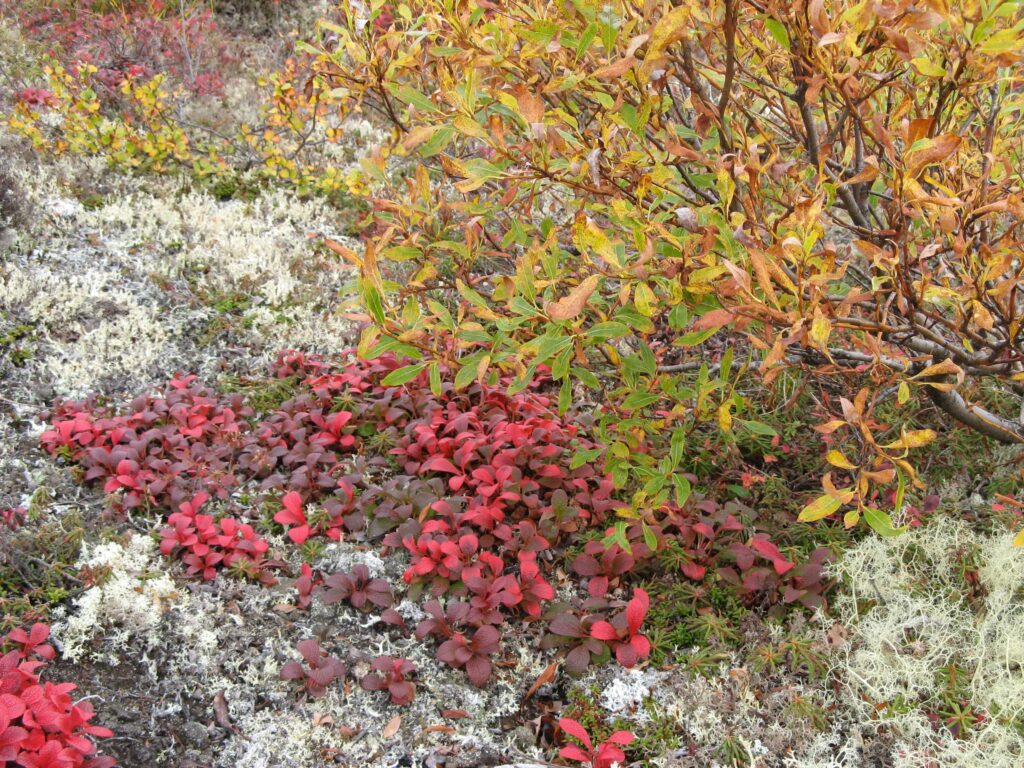
Bearberry plants are popular in food forest gardens as they thrive in all levels of sun from full to partial, or no shade. These highly functional plants offer strength and adaptability to be pioneers, medicinal properties, edible fruit and leaves, and gorgeous coloring.
They offer dark green foliage all year but turn red in fall (as pictured). Foliage stays on year-round in zones 4-8.
- Height: 6-12 inches.
- Range: North America, Britain, Northern Europe, Northern Asia.
- Climate: Zones 4-8
- Functions: Evergreen ground coverage, edible ground cover, preventing erosion,
- Light requirements: All light levels from full shade to sun.
- Soil preferences: Moist soil
You’ll find seeds, tinctures, and dried versions of this plant for sale to consume medicinally or grow. Find seeds and the value of this herb!
You can also buy this species as a plant at Nature Hills Nursery—they call it “Massachusetts Kinnikinnick”
Bergenia (Bergenia cordifolia)
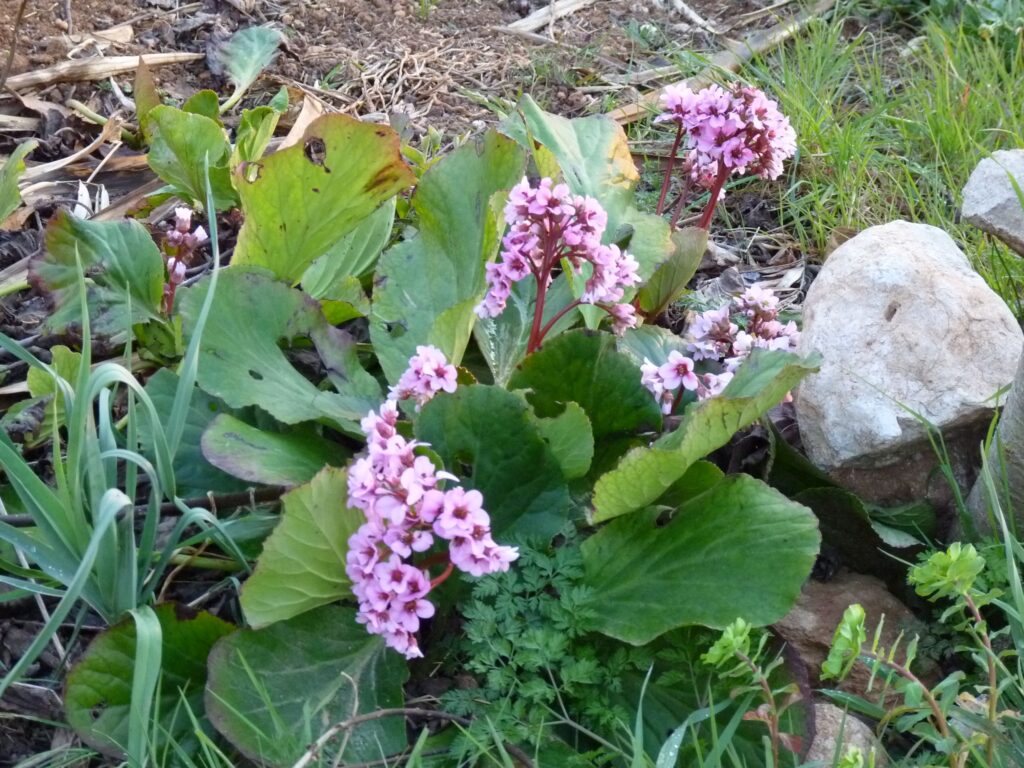
Also known as Elephant’s Ears, bergenia has large, leathery leaves and clusters of pink or white flowers.
The foliage is evergreen in zones 6-7 and above and semi-evergreen in harsh winters. Less winter wind exposure may encourage the plant to be in a position to keep its leaves longer or all year.
- Height: 6-12 inches.
- Range: Eastern Asia.
- Climate: Zones 3-9.
- Functions: Early ornamental evergreen foliage all year and flowers from March to May. Ideal for ornamental gardens for a variety of flowers and blooming times.
- Light requirements: Full or deep shade, partial shade, or full sun.
- Soil preferences: Moist soil, but tolerates drought. Suitable for heavy clay.
Seeds and plants are available here.
5 Evergreen Ground Covers for Partial Shade
Your true evergreens, perhaps the options you’ve been imagining, will require some sun to really thrive. Without a partial shade position, these evergreens may grow patchy with lots of ‘holes’ in the growth of the plant.
These options offer year-round foliage.
Creeping Juniper (Juniperus horizontalis)
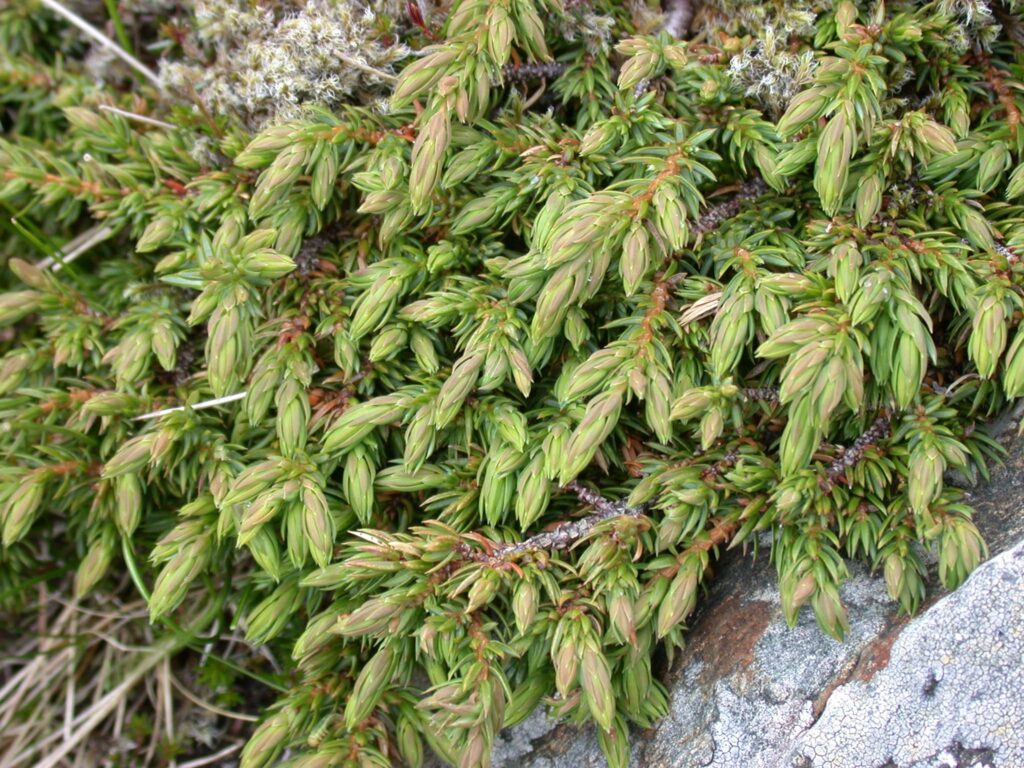
Creeping juniper is a lower-growing evergreen ground cover often used to deter deer or keep a landscape green year-round. Unlike juniper trees, the creeping juniper shrubs can thrive in partial shade.
- Height: 2 feet
- Range: North America
- Climate: Zones 4-9
- Functions: With the definite correct species, the berries and green tips of juniper are edible as beverage ingredients. Juniper is also chosen for erosion control, cascading gardens, native gardens, mass coverage, food forest borders or windbreaks, rock gardens, or along seashores as they tolerate maritime areas.
- Light requirements: Partial shade or full sun.
- Soil preferences: Moist or dry soil with good drainage and tolerates drought.
Junipers are highly versatile and useful ground covers but are a bit taller than what everyone may consider when searching for the ideal ground cover.
If creeping juniper sounds like a good choice for you, plenty of options are available. Lime green or blue-coloring with various foliage patterns.
Lingonberry (Vaccinium vitis-idaea)
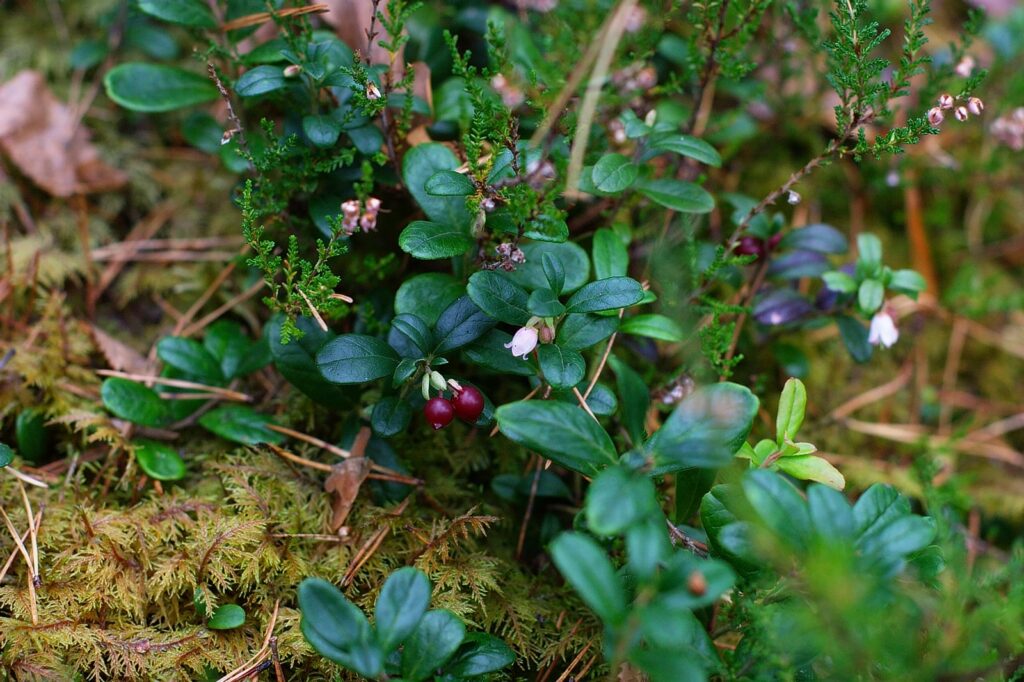
Lingonberry bushes produce edible red fruits similar to cranberries. The flowers are also very attractive to pollinators. This plant is a popular food forest ground cover.
- Height: 12-18 inches.
- Range: Europe and Asia.
- Climate: Zones 3-8.
- Functions: An ornamental and edible evergreen ground cover. Attract pollinators.
- Light requirements: Best in partial shade.
- Soil preferences: Moist soil.
Seeds to grow this precious shrub are available (surprise, surprise) here on Etsy.
Siberian Carpet Cypress (Microbiota decussata)
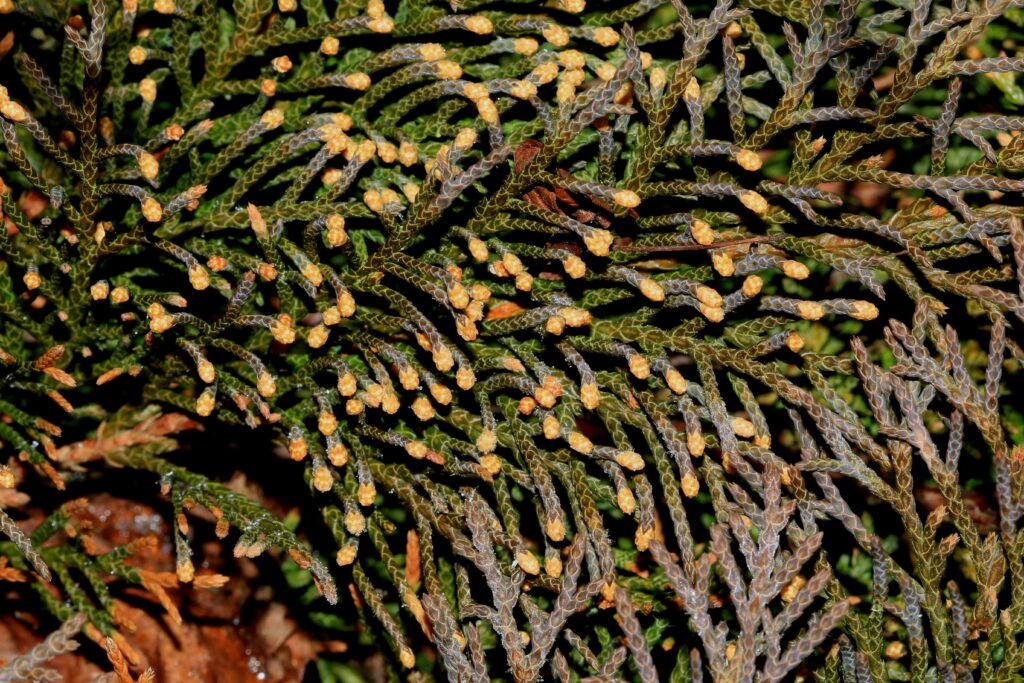
A soft coniferous ground cover with a dense and low growing habit makes a beautiful year-round evergreen ground cover.
- Height: 18-24 inches.
- Range: Eastern Siberia.
- Climate: Zones 2-8.
- Functions: Evergreen beauty.
- Light requirements: Partial shade.
- Soil preferences: Well-drained.
Plants are available at Nature Hills Nursery. Bookmark this to check back if it’s currently out of stock.
Pine-Mat Manzanita (Arctostaphylos nevadensis)

Pine-Mat Manzanita is an evergreen suitable for growing near seashores and partial shade. It’s less often grown compared to bearberry (Arctostaphylos uva-ursi)—a closely related species.
Bearberry is hardy to zone 4 and thrives in full shade, but not near seashores.
So you could grow pine-mat manzanita if you’re near the sea and have partial shade to fill, or bearberry if you have full shade and are not near the sea.
- Height: 10-18 inches
- Range: Native to North America
- Climate: Zones 5-9
- Functions: Pollinator plants for bees, and evergreen ground coverage. Edible fruit and medicinal qualities. Often used in native, woodland, or food forest gardens.
- Light requirements: Partial shade.
- Soil preferences: Moist, acidic, and well-drained soil.
Seeds are available here.
Shore Juniper (Juniperus conferta)
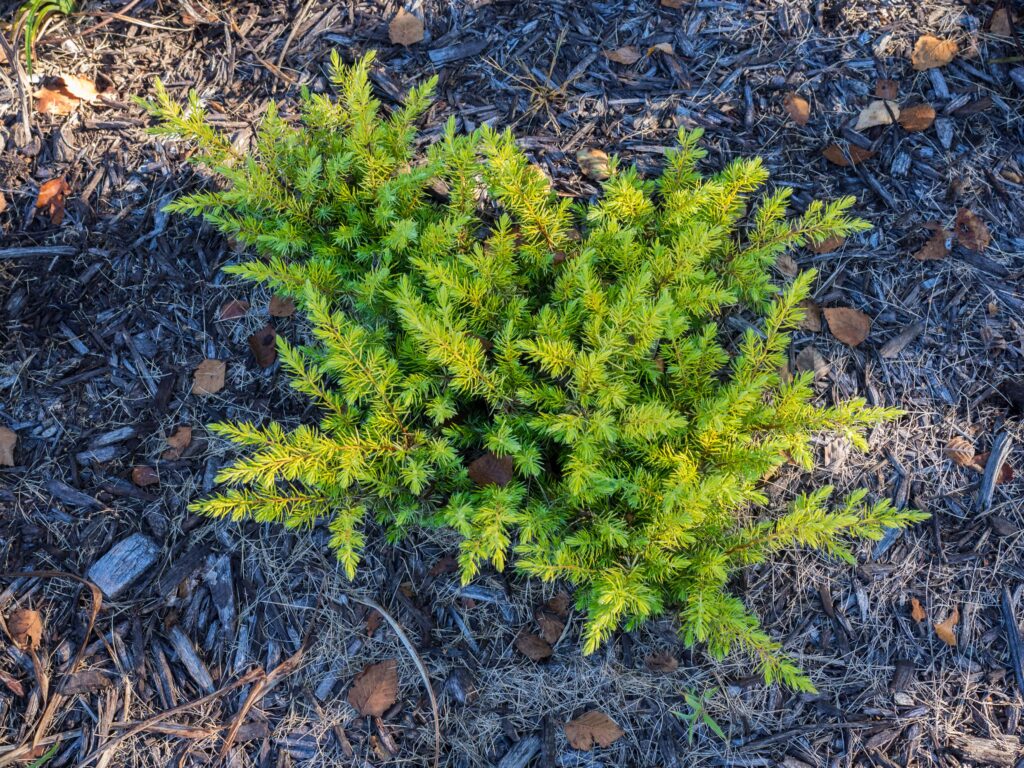
Most junipers need full sun but shore juniper is tolerant to partial shade. Junipers are a preferred ground cover for an evergreen and deer or rabbit resilient landscape.
- Height: 10-18 inches
- Range: Native to Asia
- Climate: Zones 6-10
- Functions: Evergreen ground coverage. Edible fruit (on true junipers) is used to make cocktail bitters! Erosion control on slopes.
- Light requirements: Partial or no shade.
- Soil preferences: Moist or dry soil with drainage. Tolerates drought. Suitable for seashores, and shallow or rocky soils.
Also known as ‘pacific blue’ this juniper is available here in containers.
8 Semi-Evergreen Ground Covers for Full Shade
Semi-evergreen plants will keep their foliage for the majority of the year. Only for a very short time in the coldest of months may they shed their leaves.
These choices can grow in full-shade or partial-shade positions.
Lesser Periwinkle (Vinca minor)
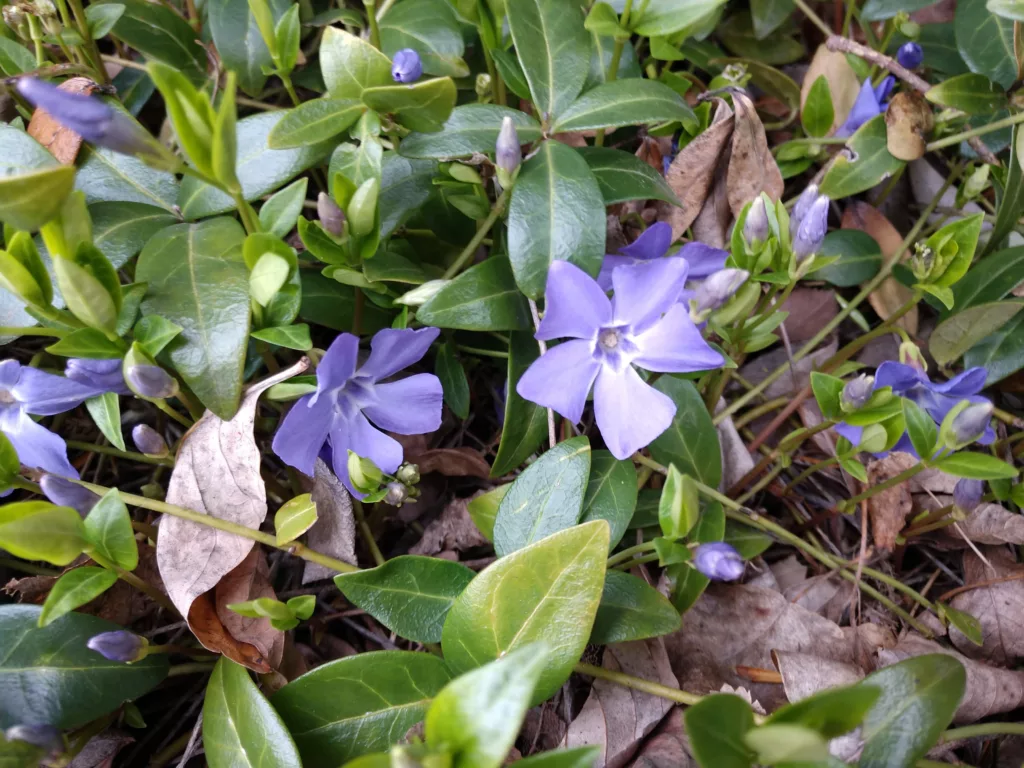
Also called Periwinkle, this is a semi-evergreen ground cover with blue-purple flowers. It’s a fast-growing erosion controller and a popular choice for dry shady spaces.
Although popular, it may be considered invasive or naturalizing in your area.
- Height: 6 inches
- Range: Europe and Asia
- Climate: Zones 4-9
- Functions: Ornamental flowering from April to May with season-round attractive foliage. Erosion controlling ground cover for rock gardens, food forests, steep slopes, shady areas, and borders.
- Light requirements: Full/deep shade to partial shade, or no shade.
- Soil preferences: Moist or dry soil and tolerates drought. Suitable for various soil types including heavy clay.
Plants are available here and seeds are here. Ordering seeds offers pink and other flower colors, but a container allows for quicker establishment.
Creeping Jenny (Lysimachia nummularia)
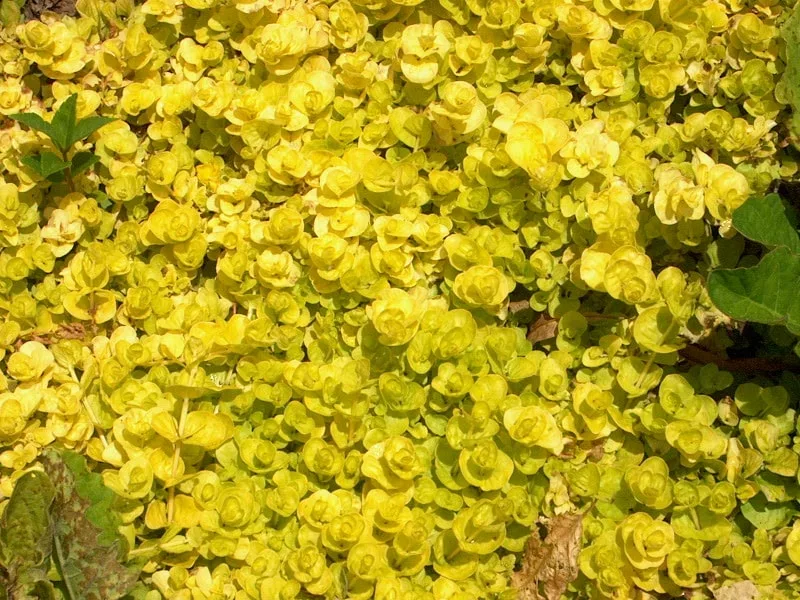
Various kinds of creeping jenny provide gorgeous ground coverage. Pictured, is bright yellow known by ‘Aurea.’ The one known by Lysimachia nummularia ‘green’ also has vibrant foliage but of a bright green shade of color.
The rounded leaves make this a popular ground cover that brightens the dark of any shade.
- Height: 3-6 inches.
- Range: Native to Europe.
- Climate: Zones 3-9.
- Functions: Ornamental ground cover flowering from June to August but provides attractive evergreen foliage. Low maintenance. Easy to grow.
- Light requirements: Partial shade is preferred. Also grows well in bright full shade. Tolerates dense full shade and will grow toward brighter areas.
- Soil preferences: Moist, boggy, or wet soil. Suitable for heavy clay.
Potted plants or seeds are available.
Jerusalem Sage/Lungwort (Pulmonaria saccharata)
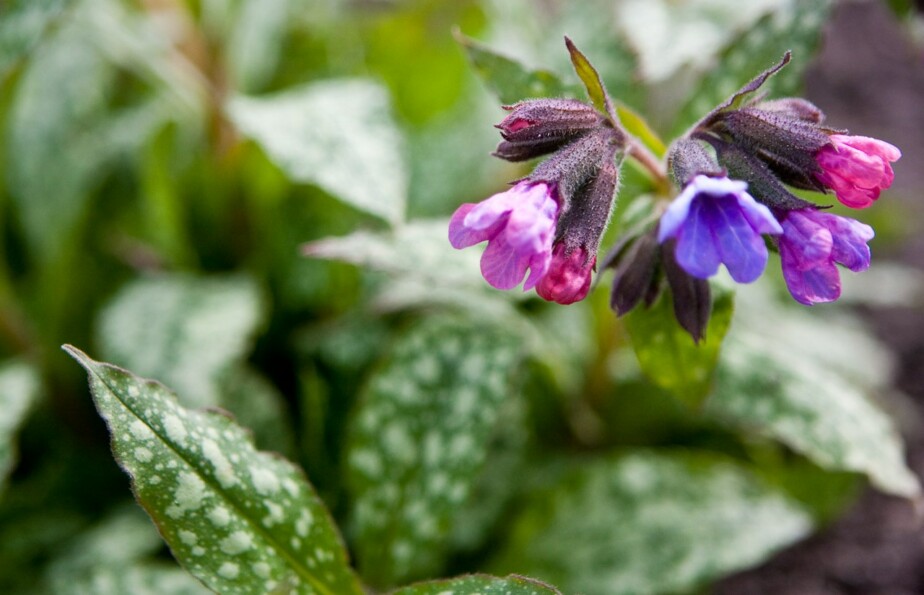
Fun fact, if you have a walnut that nothing grows under, plant lungwort! They thrive in all light conditions from full to partial shade and aren’t affected by the anti-plant chemical that black walnut trees produce.
- Height: 12-18 inches
- Range: Europe
- Climate: Zones 4-8
- Functions: Accompanied by purple flowers, the spotted semi-evergreen leaves are rough with coarse hairs. Deer and rabbits tend to avoid the plant for its texture. This ground cover is best used as a pest-deterring ornamental.
- Light requirements: Full/deep shade to partial shade or full sun.
- Soil preferences: Moist soil is ideal but tolerates drought.
Nature Hills Nursery currently offers 4 types of lungwort.
Wild blue phlox (Phlox divaricata)
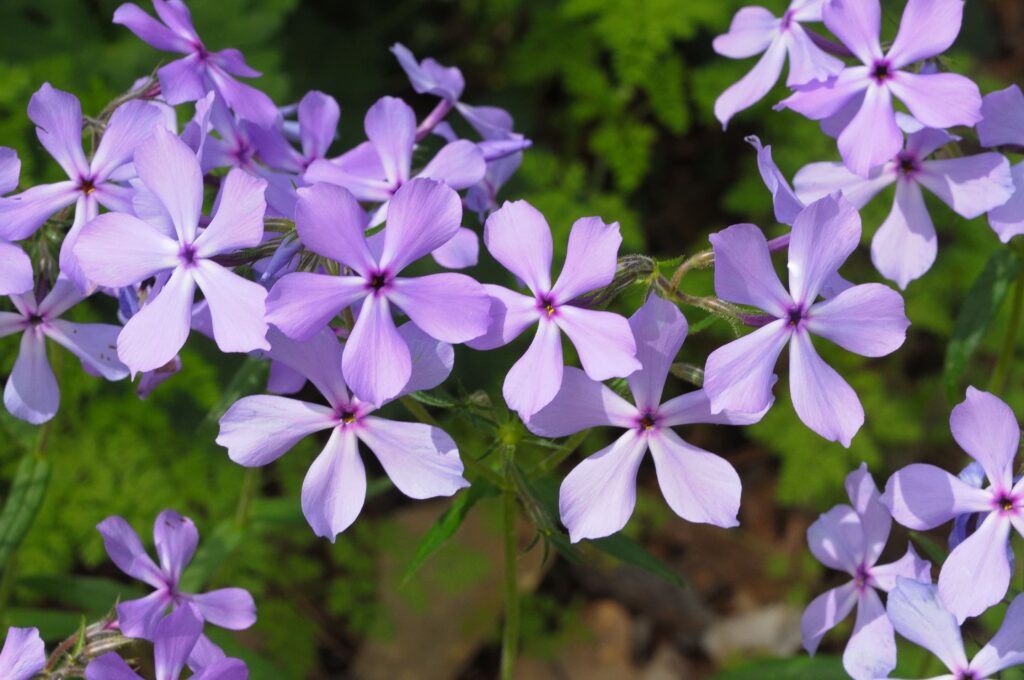
This variety of phlox thrives and flowers in both full and partial shade. It’s native and often included in food forests as a ground cover to attract wildlife and important pollinators. The foliage is considered evergreen, but I would call it semi-evergreen as it is not green during the snowy winter months!
- Height: 6-12 inches
- Range: North America
- Climate: Zones 4-9
- Functions: Best planted when needing a pollinator magnet and gorgeous ornamental ground cover.
- Light requirements: Full/deep shade to partial shade or full sun.
- Soil preferences: Moist soil and drought tolerant.
Etsy offers wild blue phlox seeds here and grown plants are offered here.
Allegheny spurge (Pachysandra procumbens)
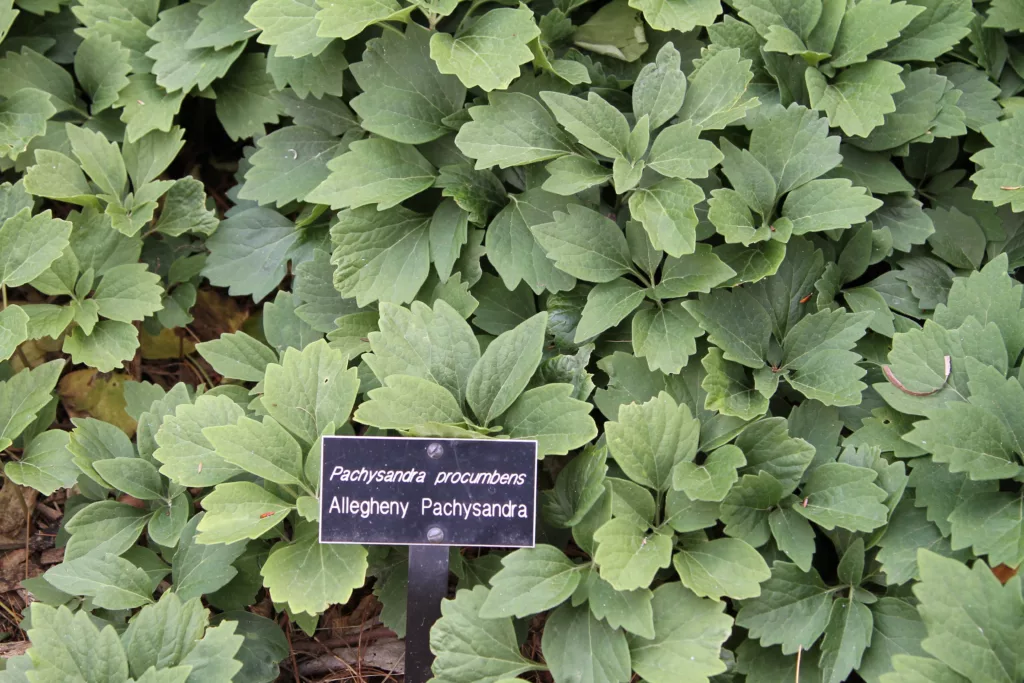
A shade-thriving semi-evergreen ground cover has A LOT to offer and is often included in polycultures.
- Height: 6-12 inches
- Range: Native to North America
- Climate: Zones 5-8
- Functions: Popular spring-fragrant semi-evergreen ground cover for native, rock, woodland, and food forest gardens. Dense carpeting formation, drought tolerant when established, adaptable to most soil types, and stays lush green with little effort.
- Light requirements: Full or partial shade
- Soil preferences: Moist soil. Acidic to neutral pH. Suitable for heavy clay.
A tougher variety to find from seed, but is often available in containers. Scotts Garden Center for Canadians or Rare Roots for Americans.
Chinese Wild Ginger (Asarum splendens)

Various semi-evergreen wild ginger ground covers are available for the choosing. Chinese wild ginger is hardy to zone 5. The others are hardier—to zone 3 and zone 4. If you’re in zone 5-8 you can grow any or all of these wild gingers if you so choose!
- Height: 8 inches
- Range: Native to Asia
- Climate: Zones 5-9
- Functions: Edible roots and ornamental planting. Woodland gardens, pest resistance, and shaded edges.
- Light requirements: Full shade or partial shade.
- Soil preferences: Dry or moist soil with good drainage.
You’ll find wild ginger available by seed or root here.
Rose Of Sharon (Hypericum calycinum)
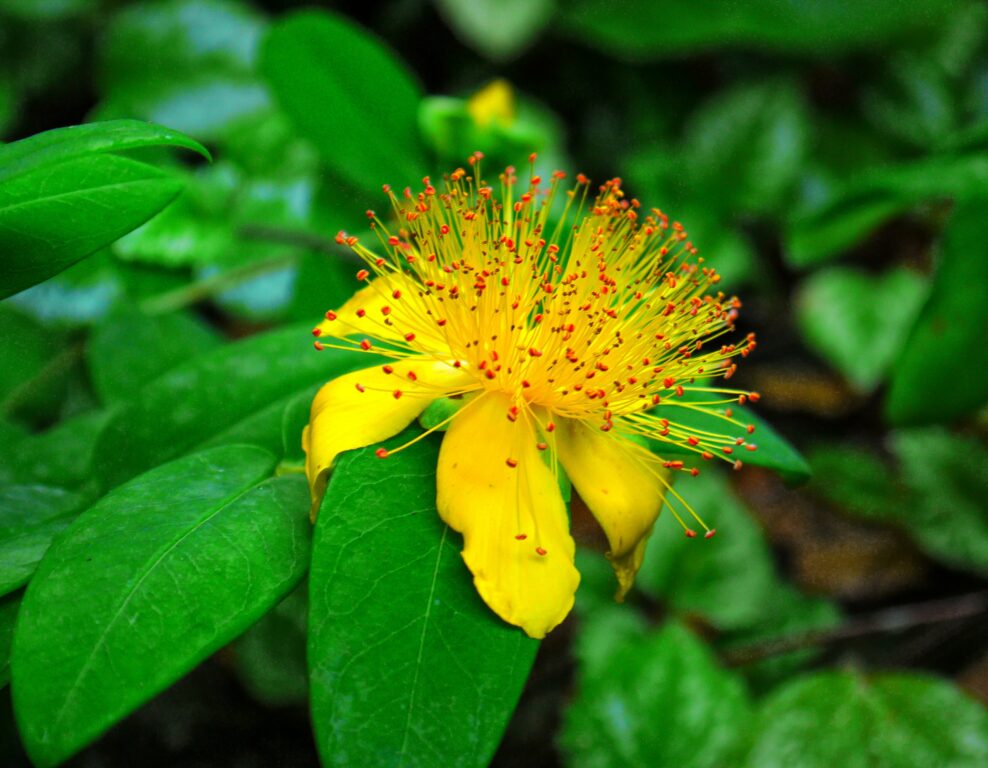
Often mislabelled (or alternatively labeled) as St. Johns Wort (Hypericum perforatum), Rose of Sharon (Hypericum calycinum) is shorter, with larger flowers, and better suited when looking specifically for ground covers!
Both plants will technically “cover the ground” by taking space, but if you’re looking for a showy and low-growing ornamental you’ll love the rose of Sharon. Rose of Sharon is also a shade lover and even thrives in a full shade position, unlike St John’s wort.
- Height: 12-18 inches
- Range: Asia
- Climate: Zones 5-10
- Functions: Used as an ornamental semi-evergreen ground cover. Prevents erosion, is gorgeous when cascading, and attracts butterflies.
- Light requirements: Deep, full, semi, or no shade.
- Soil preferences: Moist or dry soil and drought tolerant. Suitable for heavy clay.
Consider an alternative if invasive in your area, please check before committing.
Nature Hill’s Nursery offers two types of Rose of Sharon (and calls them St. Johns Wort). If you prefer to grow from seed, plenty of options with free shipping are available here.
Pennsylvania sedge (Carex pensylvanica)
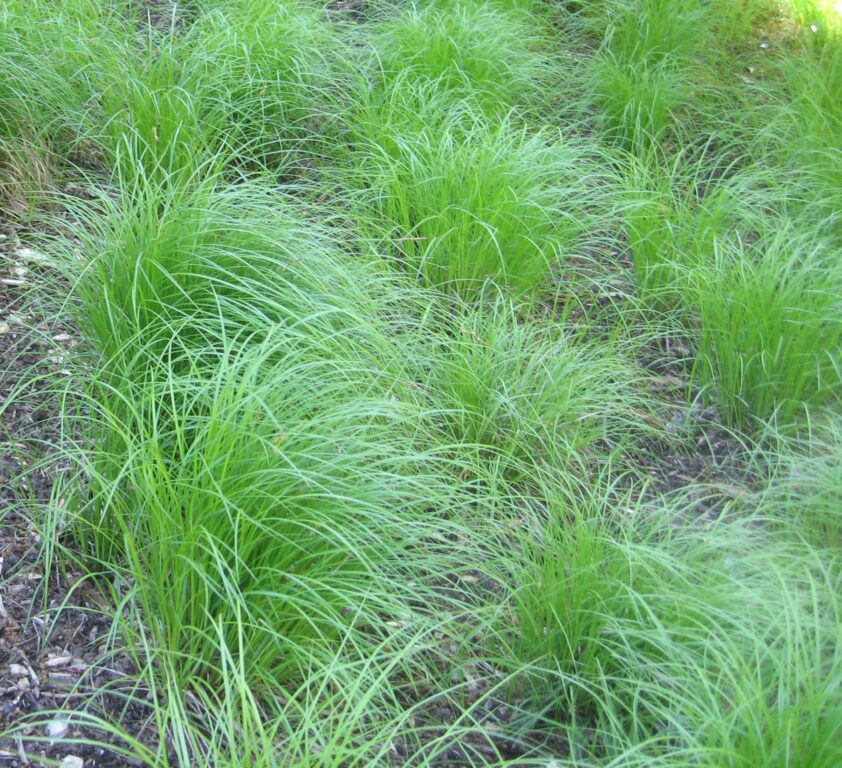
This grassy-looking semi-evergreen native attracts wildlife—in good ways—and stabilizes the soil whether it’s moist or dry. With a bit of mulch, you’ll be able to set and forget it after establishing.
- Height: 6-12 inches
- Range: North America
- Climate: Zones 4-8
- Functions: A perfect ground cover for dry shade to prevent erosion and emptiness, or lawn replacement for heavy-shaded areas.
- Light requirements: Full/deep shade to partial shade or full sun.
- Soil preferences: Moist soil and tolerates drought.
This sedge is available here (currently at 17% off).
Bristleleaf sedge (Carex eburnea) hardy to zones 2-8 is also an option or alternative if you’d like variety or a colder climate option.
4 Semi-evergreen Ground Covers for Partial Shade
The final few in this list grow best with at least partial shade. They need a minimum of 3 hours of sunlight per day to fill in and grow lush. No one wants a straggly lackluster ground cover!
Rock Cress (Arabis caucasica)
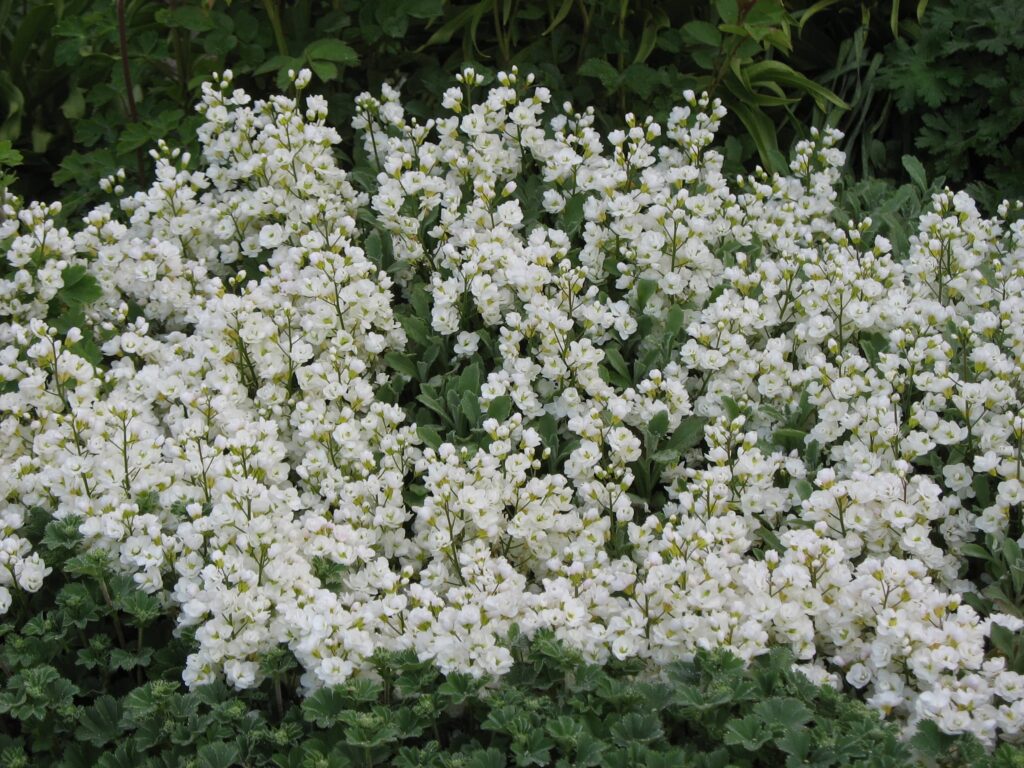
If you have poor soil and partial shade, go with rockcress! The leaves are edible, semi-evergreen, and carpet-forming.
- Height: 4-9 inches
- Range: Europe
- Climate: Zones 4-9
- Functions: Often used as an ornamental plant in poor soil situations in rock gardens, along crumbly borders, cascading down walls, or in pollinator gardens. The plentiful flowers attract bees.
- Light requirements: Partial shade
- Soil preferences: Moist or dry soil and tolerates drought. Grows best in poor soil rather than rich ones.
When choosing between all the available colors, try not to get carried away!
Trailing Bellflower (Campanula poscharskyana)
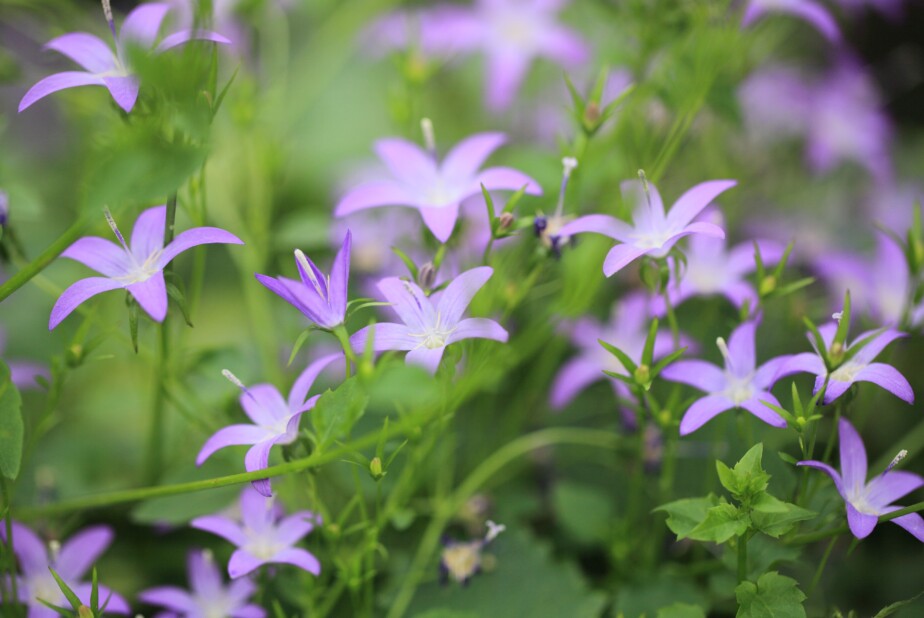
An edible and low-growing semi-evergreen plant with pretty purple flowers.
- Height: 4-10 inches.
- Range: Native to Europe.
- Climate: Zones 3-7.
- Functions: Attracting pollinators. Edible flowers and leaves. Dense ground coverage with blooms from June to August flowers.
- Light requirements: Partial shade is best.
- Soil preferences: Moist soil.
Seeds for white or purple flowers are available here.
Lily Turf (Liriope spicata)
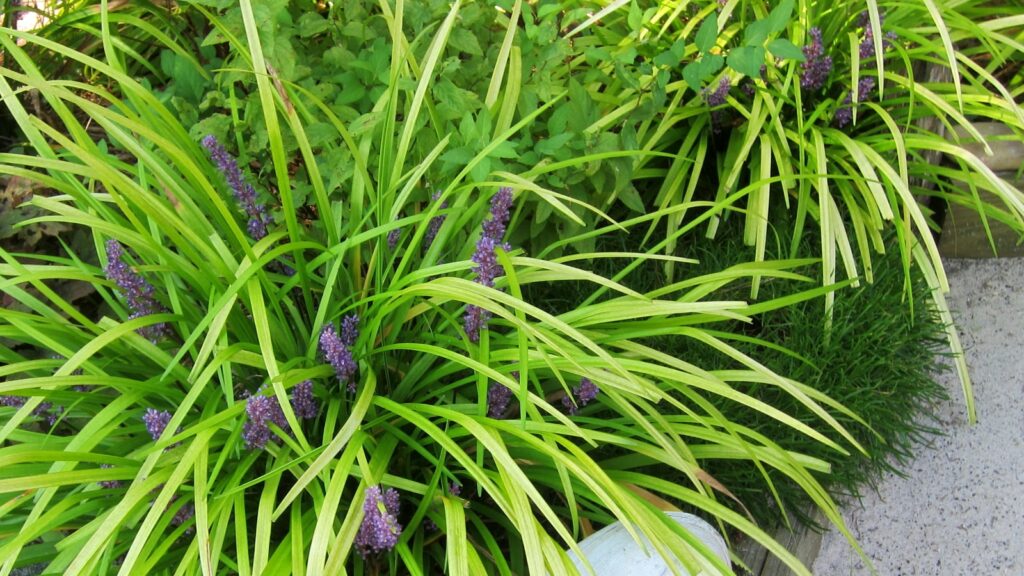
Lily turf is a popular semi-evergreen used as a ground cover in various types of partially shaded areas. It’s suitable for rocky soils, hillsides, seashores, or woodland gardens. It isn’t, however, native to North America and may be considered invasive. Check before choosing this as a ground cover!
- Height: 8-16 inches
- Range: Asia
- Climate: Zones 4-10
- Functions: Ornamental. Edible leaves, roots, and shoots. Ideal for adding diversity to a forest garden’s ground cover layer. Trap for slugs.
- Light requirements: Partial shade.
- Soil preferences: Moist soil and tolerates droughts.
Lilyturf plants are available here and seeds are here.
Wall Germander (Teucrium chamaedrys)

If you’re looking for a lush but low-growing plant that acts like a hedge, this is a great option. It’s semi-evergreen and densely covers the ground with fine foliage and deep pink flower spikes.
- Height: 10-12 inches
- Range: Native to Europe
- Climate: Zones 5-9
- Functions: Often used as an ornamental, fragrant, and low growing hedge or border in or around rocks. Bees pollinate the flowers from July to September. They also attract beneficial wild life and serve as a ‘scent-confuser’ that may help prevent pest imbalances.
- Light requirements: Partial shade is ideal.
- Soil preferences: Moist or dry soil. A wide range from light to heavy soils. Suitable for heavy clay.
Plants or seeds are available here or here.
Up next: 22 Low-Growing (Creeping) Evergreen Ground Covers
Bonus idea: Gourmet Mushrooms
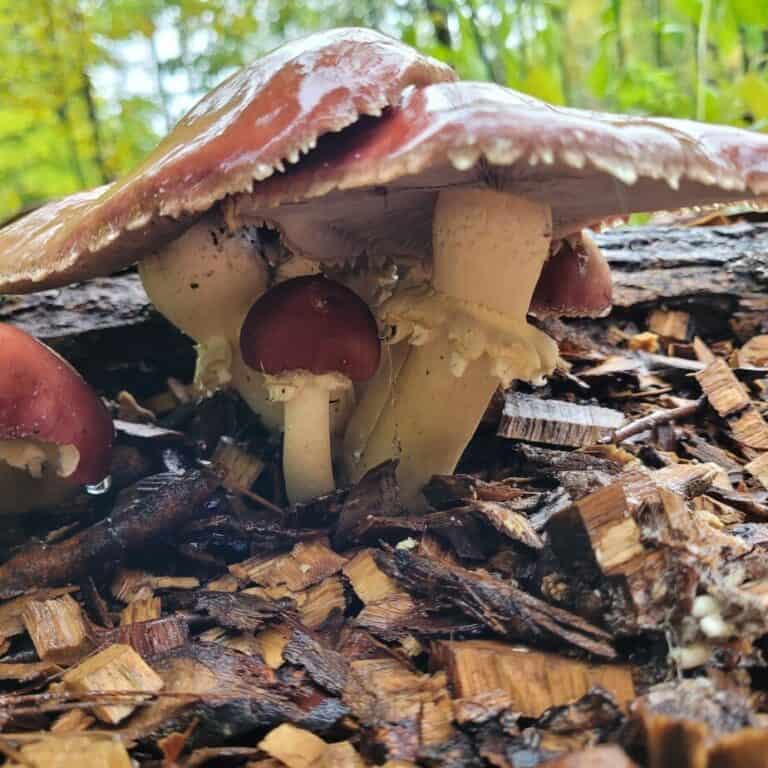
Okay, not an “evergreen” but a shade-loving ground cover! If you plan to put mulch between your evergreen ground covers, consider adding edible mushrooms to the mix!
Not best if you’re after a long-lasting ornamental mulch for this space. But for any other space where you grow edible perennials, mushroom-inoculated mulch is highly rewarding!
Fresh mushrooms grown from woodchips are deliciously edible and wood chips offer gorgeous ground coverage while you wait for dinner to spontaneously pop out of the ground.
See: Grow a Mushroom Garden at Home in 4 Steps
Recent Posts
There’s no shortage of full-sun ground covers for zone 4 climates! Each plant in this list can withstand the frigid temperatures and also enjoy the hot sun in summer. Full sun means that a plant...
There's no shortage of full sun ground covers, not even in zone 3! Zone 3 climates offer hot but short-lived summers and very cold winters. So each plant in this list can withstand the frigid...
